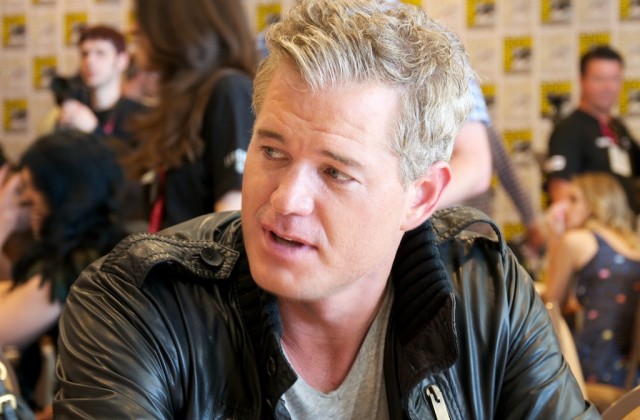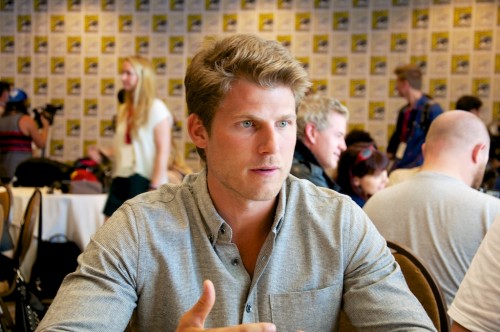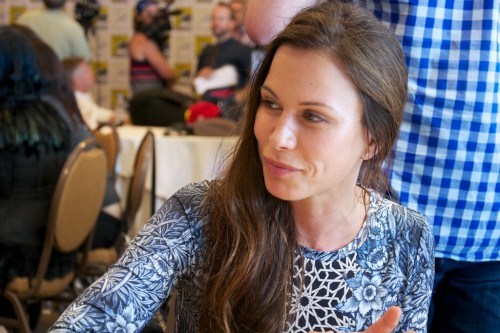The Last Ship at SDCC: What we learned

‘The Last Ship’ came to San Diego Comic-Con in a big way, from a convention panel to NerdHQ to a party on the deck of the USS Midway. We sat down with the cast and creators; this is what we learned.
TNT’s The Last Ship has been one of the surprise hits of the summer, drawing in over 5 million viewers in its premiere. The network brought the cast and creators to San Diego Comic-Con and even threw a big party on the deck of the USS Midway. We talked with the cast and writers of the show, including Eric Dane (Tom Chandler), Rhona Mitra (Rachel Scott), Charles Parnell (Russell Jeter), Travis Van Winkle (Danny Green) and producers Steve Kane and Hank Steinberg. This is what we learned about the show’s relationship with the Navy, the second season and more.
The Navy Way
Learning the “Navy Way” was an experience. Kane related a story where they’d written in a punishment for a character to be placed on kitchen duty, as they had seen in old war movies. One of the technical advisors, a ship’s captain, corrected that quickly. “The culinary specialists take that job very seriously … they are the ones that keep the troops fed, that keep morale up. If they saw you punishing somebody else by giving them their job, it would make their job feel like crap to them.”
“The greatest thing about the Navy is that they’ve been studying leadership since 1775. They’ve made a lot of mistakes over the years and they’ve learned from them, codified them and are constantly updating it.” The producers wanted to make sure that history – in its own way – is represented in the show. They cannot get everything on this show perfect from a technical perspective, but they are proud of everything they get right, especially this. Kane shares a great story about the many different ways of saying “roger that,” that’s in the video.
Aboard the USS Halsey
Many of the actors were not particularly familiar with the Navy and how they do things. Dane’s father was an Ensign, and Baldwin’s father served in the Naval Air Corps in World War II, but everyone else received their first real Navy experience when they spent a couple of days aboard ship. The cast – and some of the crew … those that don’t get seasick – took a familiarization tour on the USS Halsey, experiencing torpedo evasion drills and shooting the 5-inch cannon fired. Dane spent time with CAPT Mike Weeldreyer and learned from him. “I got to see how he behaved when a couple things went wrong, how everything was a learning experience for him and his crew. He always asked his crew ‘what can we take away from this and how can we do it better next time?’”
Van Winkle worked with the members of the Navy’s elite fighting force that were advisors: “Michael Bay’s first request to me was, ‘Hang around the Navy SEALs on set; breathe them in.’” He expected them to be grizzled, war-heavy veterans, but was found them to be “tender, genuine and creative people.”
For Mitra, the research was different. Fortunately, she had taken an interest in virology before The Last Ship came around, “I was studying neurotoxins and their impacts classes of species … so I get the opportunity to talk to virologists every day and geek out.”

Baldwin also enjoyed working with the military. “It’s an honor to be aboard of Navy Guided Missile Destroyer … it’s been humbling and a great learning process for me … I just want to serve them well. And the virus? I ain’t worried about no fricking virus.”
Location shooting pros and cons
The entire pilot was shot on ship, but they’ve built sets after that. “You can’t ask the Navy to give you a ship for six months … they’ve got other things they’ve got to do,” kids Steinberg. They did two additional location shoots after the Pilot, for a total of two weeks. Filming obviously jumped around during those shoots, which made for production challenges. “We would doing episode two, episode nine, episode seven today … where are we?!? But we couldn’t have done that had the creators not kept so organized and had the backing of TNT,” added Baldwin.
Shooting on a ship, especially the interiors, presents challenges. Dane: “The geography of the shooting spaces are very tight. You can become a little stilted when shooting in that environment; you’ve got to learn how to stay loose.” The ships are tight quarters to begin with, but adding in camera crews, boom operators and the like makes things even more crowded.
The production incorporated the real crews of the ships they filmed on when they could. “We used the actual Navy enlisted and officers for certain roles when we need them … Who better to do their job than the guys that do their job” explains Dane.
Apocalypse Now-ish
Despite the continued efforts (at our table) to classify the show as being post-apocalyptic, the cast and producers weren’t buying it. “This is actually an apocalyptic environment; we get to see it as it’s unfolding. It’s like ‘Apocalypse Now’ … if anybody’s used that term before I’m not aware,” kids Dane. “It’s an interesting subject matter for me; I think it’s rich in story telling and the characters are great.” Steinberg adds, “The difference between our and any other show or movie is that our guys can stop it. That’s the key; the show is about the hope and these people hanging on and being heroic in the face of all odds. That’s what gives this show its urgency. It’s got a ticking clock. Every day they don’t come home with the vaccine is the day a half million people die.”

Despite the finality of the desertion story last week, it sounds like we might see another rift develop amongst the crew. Van Winkle: “We have more threats come at us, from unseen areas. The ship is its own culture, there are some rifts between power, and some rifts between what we need to do and how to do it … the typical drama that might come along with that.” This is a fairly important storyline in the book, and is ripe for adaptation.
When Dane was asked about the tension between Chandler and Slattery in the Pilot and whether or not it might come back up, “Absolutely. There’s always going to be friction between the CO and the XO because the XO is never going to fleet up and become a CO; there’s no government left. The only chain of command we have to preserve is the one that’s on the ship.”
The Navy’s reaction
The show knew that the Navy would bristle at the scene between Green and Foster in the Pilot. At the premiere in Washington, DC, the crowd definitely reacted. They had to have a couple of discussions with the Navy to share where their story was going. The point that they were trying to make, as we saw in episode six, was that is something that is detrimental to order.
Van Winkle is enjoying how the story is progressing. He particularly liked the moment in episode three, where he confesses his love to Foster, but tells her to stay away. “That’s actually become a hashtag on Twitter: #iloveyoustayawayfromme. It’s a complicated relationship and scenario, because all of us, within our fabric, there’s love … To have found love and be drawn to someone, it is hard when that is the one thing that gets in the way of my responsibilities.”
There’s a story told by several different people in the room that day about one Navy family’s specific reaction to the premiere screening. Look for it in the video above.
Command Master Chief Jeter: The Chaplin
As originally scripted in the Pilot, there was a separate character written for the chaplain (specifically in the funeral scene). They didn’t envision the role to be one that would show up again, and saw the opportunity to cross-utilize Parnell. “We thought he’s got the gravitas, he’s got the voice and the demeanor, and it developed in the Pilot that he would become that guy and it’s become a great thing for his character to become the spiritual leader as well,” says Kane.
“Master Chief is a man of strong backbone, a man of deep faith and a great sense of duty.” He’s a stoic man, who is going through the same pain of loss that the rest of the crew is, but cannot afford to let it show, as he’s tasked with keeping the crew on the same page. He is responsible for the enlisted crew to the officers. Including the chaplain into his character makes sense.
A “loose” adaptation
The Last Ship is based on the novel by William Brinkley, which deals with a very different story. The virus epidemic in the show replaces a nuclear holocaust in the book. Dane sees very little connective tissue between the two, “We have two things in common with the book: the name of the ship and the name of the character.” A more detailed reading, however, shows a great deal more. The tension between the CO and the XO is a major part of the book. There’s also an (admittedly different) interaction with a rival Russian crew … even the excursion to the cruise ship was lifted.
Looking ahead to Season Two
“The cliffhanger for this season is going to throw everyone on their ass,” teases Van Winkle.
“The long-term plan is to save the world. There’s a lot of saving and repairing to do. That can take many different forms and shapes,” states Time is obviously of the essence. The first season takes place over a condensed time period, but there not a plan for how much time will pass during the second season. There is a general blueprint for future seasons, but they’re open to the fluidity of the process and aren’t locked in to telling specific stories at specific times.
Would you like to know more?
The video highlights from our discussion are above, but we also have the trailer shown at The Last Ship panel, as well as the NerdHQ panel:
 CliqueClack
CliqueClack


Maybe I missed it but I would like to know the position that Tex plays. Is he a contractor? How is it that he’s even on the ship? If he is a contractor and I suspect he is, what’s his expertise?
This is a great show!! Thanks
He was introduced in the second episode. He is ex-miltiary (I THINK Army, maybe Rangers or some other type of Special Forces group) working as a private military contractor at Gitmo. Chandler brought him on board because A) He’s an uninfected American (they might not be looking for people but he’s not going to turn someone away) B) He saved their lives and C) Dude’s got a skill set Chandler can use.
From a story perspective, it allows another non-Navy character into the book, so someone who is more freely able to voice different opinions.